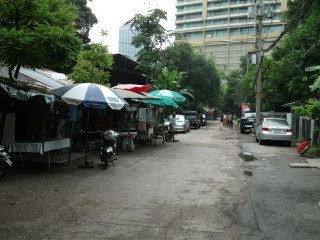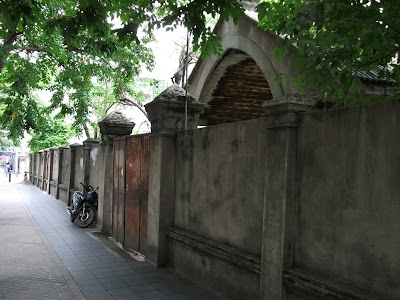I took Friday afternoon off this week and headed down to the Chao Phraya River area – the original, old part of Bangkok. I’d been to this part of Bangkok earlier – when I went to the Grand Palace and Wat Pho. This time, my goal was to see the Museum of Siam and then to have a drink on the terrace of the Arun Hotel. The Arun Hotel had been recommended to me as a good place to watch the sun set behind Wat Arun – one of the quintessential sights of Bangkok.
(On a side note, I feel like I’ve made a lot of “progress” since the last time I visited this area. To get there, you take the SkyTrain to the Saphan Taksin stop and then the ferry to the Wat Pho stop. The first time I did this, the vendors at the Saphan Taksin pier recommended I buy a one-day pass on the ferry. It was 120 baht (about $4) so not a big deal. But this time, I knew that I could just buy a ticket on the ferry itself and that it would be a lot cheaper. So, when the ferry pulled in, I jumped on, found a seat, and waited for the attendant to come by. And I was pleased to be able to say “Tha Tien” as my destination and to understand “sip see” as “14” when she told me the price. Felt like a regular local.)
Took the ferry to Tha Tien pier, walked past Wat Pho, and found the Museum of Siam. The building is from the late 1800s – which seems to be a theme for this part of town. The focus is on the history of Thailand, and in particular, how Bangkok came to be the capital. Turns out that the original center of Bangkok was laid out to mirror the layout of Ayutthaya – the original capital further to the north. And, for some odd reason, there was also an exhibit on the “mod period” in Thailand.


This part of Bangkok is becoming my favorite part of town to visit. The Sukhumvit area where I live and work is filled with sleek high-rise buildings, over-the-top shopping malls, and high-end restaurants. All the conveniences of modern living and it certainly makes living here in Bangkok easier, but it’s almost all contemporary and it’s hard to see any remnants of the original Bangkok. But, in the areas along the river there are still small buildings and shops and it’s easier to get a sense of what life was like before Bangkok became a modern metropolis. The scale is more personal, more intimate, with lots of small businesses crammed with products.





After the museum, I found the Arun Hotel – it is literally right on the Chao Phraya River. It has a restaurant on the first floor and then a rooftop bar, both with great views of Wat Arun across the river. Fortunately, you don’t have to be a hotel guest to have a drink at the bar. There were a few other people there as well – all come to watch the sunset. Based on their accents, I’m guessing there were Australians, Germans, and Italians. That’s one thing I’ve noticed – very few American tourists here. Not sure if it’s the distance or the political protests earlier this year, but I’ve not seen or heard many American tourists in Bangkok.
Here are a few pictures of Wat Arun as the sun sets.






(By the way, one of the things I noticed when I first got here was that the sun seemed to set very quickly. I thought I was just imagining things, but I recently googled “sunset near the equator” and it turns out that, in fact, the sun does set more quickly near the equator. Not sure I understand the details, but it has something to do with the angle of the sun in this part of the globe versus, say, in New England. Basically, the sun is up and then it’s down and there really isn’t a twilight here.)


























 After the museum, I found the Arun Hotel – it is literally right on the Chao Phraya River. It has a restaurant on the first floor and then a rooftop bar, both with great views of Wat Arun across the river. Fortunately, you don’t have to be a hotel guest to have a drink at the bar. There were a few other people there as well – all come to watch the sunset. Based on their accents, I’m guessing there were Australians, Germans, and Italians. That’s one thing I’ve noticed – very few American tourists here. Not sure if it’s the distance or the political protests earlier this year, but I’ve not seen or heard many American tourists in Bangkok.
After the museum, I found the Arun Hotel – it is literally right on the Chao Phraya River. It has a restaurant on the first floor and then a rooftop bar, both with great views of Wat Arun across the river. Fortunately, you don’t have to be a hotel guest to have a drink at the bar. There were a few other people there as well – all come to watch the sunset. Based on their accents, I’m guessing there were Australians, Germans, and Italians. That’s one thing I’ve noticed – very few American tourists here. Not sure if it’s the distance or the political protests earlier this year, but I’ve not seen or heard many American tourists in Bangkok.




 (By the way, one of the things I noticed when I first got here was that the sun seemed to set very quickly. I thought I was just imagining things, but I recently googled “sunset near the equator” and it turns out that, in fact, the sun does set more quickly near the equator. Not sure I understand the details, but it has something to do with the angle of the sun in this part of the globe versus, say, in New England. Basically, the sun is up and then it’s down and there really isn’t a twilight here.)
(By the way, one of the things I noticed when I first got here was that the sun seemed to set very quickly. I thought I was just imagining things, but I recently googled “sunset near the equator” and it turns out that, in fact, the sun does set more quickly near the equator. Not sure I understand the details, but it has something to do with the angle of the sun in this part of the globe versus, say, in New England. Basically, the sun is up and then it’s down and there really isn’t a twilight here.) 





 And if the push-cart approach isn’t appealing, you can always go the brand-name route with Puff & Pie. Or Dunkin’ Donuts.
And if the push-cart approach isn’t appealing, you can always go the brand-name route with Puff & Pie. Or Dunkin’ Donuts. 




 But my favorite was this woman. She is rocking that pink dress and seems quite pleased to be doing her part to make the Bangkok street scene so entertaining.
But my favorite was this woman. She is rocking that pink dress and seems quite pleased to be doing her part to make the Bangkok street scene so entertaining. 
 A lot of foreigners on assignment and expatriates live in this part of Bangkok. The neighborohood is definitely a jumble. In my neighborhood, sois 3, 5, and 7 are strongly Muslim – you see many women in burqas in the supermarket. But cross Sukhumvit and go down sois 12 and 16 and there are good French restaurants that cater to the “ladies who lunch” set. Soi 18 has a Lexus dealer on the corner and, 20 yards away, a low-rent Chinese noodle shop where we often go for lunch. Sois 23 and 31 have a lot of neighborhood restaurants – mostly Thai, but also Italian and Indian. Sois 49, 51, and 53 are more up-market, with lots of antique and furniture stores. By the time you get to Soi 55, you have crossed into the Thong Lor neighborhood, which has a strong Japanese presence.
A lot of foreigners on assignment and expatriates live in this part of Bangkok. The neighborohood is definitely a jumble. In my neighborhood, sois 3, 5, and 7 are strongly Muslim – you see many women in burqas in the supermarket. But cross Sukhumvit and go down sois 12 and 16 and there are good French restaurants that cater to the “ladies who lunch” set. Soi 18 has a Lexus dealer on the corner and, 20 yards away, a low-rent Chinese noodle shop where we often go for lunch. Sois 23 and 31 have a lot of neighborhood restaurants – mostly Thai, but also Italian and Indian. Sois 49, 51, and 53 are more up-market, with lots of antique and furniture stores. By the time you get to Soi 55, you have crossed into the Thong Lor neighborhood, which has a strong Japanese presence.

 At one point, I ended up on a soi that dead-ended into a Buddhist temple. Very ornate and complete with monks in saffron robes.
At one point, I ended up on a soi that dead-ended into a Buddhist temple. Very ornate and complete with monks in saffron robes.


 The street was just an average neighborhood street... but, in true Thai fashion, there was retail everywhere.
The street was just an average neighborhood street... but, in true Thai fashion, there was retail everywhere. I am convinced that no one in Thailand has a kitchen in their home – there are small restaurants and street stalls everywhere – and someone has to be eating all that food.
I am convinced that no one in Thailand has a kitchen in their home – there are small restaurants and street stalls everywhere – and someone has to be eating all that food.